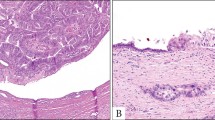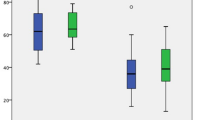Abstract
Although considerable progress has been made in our understanding of intraductal papillary mucinous neoplasm (IPMN) of the pancreas, some issues still remain to be resolved. Uncertainty exists regarding the classification of IPMNs. The necessity of the mixed-type category of IPMN and whether such lesions should be defined radiographically or histologically needs to be determined. The preoperative distinction of branch duct IPMNs from nonmucinous cysts should be further investigated so that potentially malignant lesions can be identified and management strategies guided effectively. The role and safety of cystic fluid analysis remains to be clarified in this context. With regard to the diagnosis of malignancy in branch duct IPMNs, criteria for identifying malignancy need to be re-evaluated. The presence of mural nodules is a very reliable predictor; however, controversy exists over the value of size as a reliable indicator. Criteria with increased specificity are needed, perhaps including histological subtype of lesion, to reduce the false-positive rate of the present criteria. Finally, the best modality and interval for surveillance of branch duct IPMNs requires determination because of its significance in terms of malignant transformation, development of distinct ductal adenocarcinoma and disease recurrence after resection.
This is a preview of subscription content, access via your institution
Access options
Subscribe to this journal
Receive 12 print issues and online access
$209.00 per year
only $17.42 per issue
Buy this article
- Purchase on Springer Link
- Instant access to full article PDF
Prices may be subject to local taxes which are calculated during checkout

Similar content being viewed by others
References
Ohhashi, K. et al. A case of cystadenocarcinoma of the pancreas forming bilio-pancreatic fistula [Japanese]. Prog. Dig. Endosc. 17, 261–264 (1980).
Klöppel, G. et al. Histological Typing of Tumours of the Exocrine Pancreas, 2nd edn (Springer-Verlag, Berlin, 1996). [Series title World Health Organization International Histological Classification of Tumours].
Tanaka, M. et al. International consensus guidelines for management of intraductal papillary mucinous neoplasms and mucinous cystic neoplasms of the pancreas. Pancreatology 6, 17–32 (2006).
Tanaka, M. Intraductal papillary mucinous neoplasm of the pancreas: diagnosis and treatment. Pancreas 28, 282–288 (2004).
Crippa, S. et al. Mucin-producing neoplasms of the pancreas: an analysis of distinguishing clinical and epidemiologic characteristics. Clin. Gastroenterol. Hepatol. 8, 213–219 (2010).
Lewandrowski, K. B., Southern, J. F., Pins, M. R., Compton, C. C. & Warshaw, A. L. Cyst fluid analysis in the differential diagnosis of pancreatic cysts. A comparison of pseudocysts, serous cystadenomas, mucinous cystic neoplasms, and mucinous cystadenocarcinoma. Ann. Surg. 217, 41–47 (1993).
van der Waaij, L. A., van Dullemen, H. M. & Porte, R. J. Cyst fluid analysis in the differential diagnosis of pancreatic cystic lesions: a pooled analysis. Gastrointest. Endosc. 62, 383–389 (2005).
Linder, J. D., Geenen, J. E. & Catalano, M. F. Cyst fluid analysis obtained by EUS-guided FNA in the evaluation of discrete cystic neoplasms of the pancreas: a prospective single-center experience. Gastrointest. Endosc. 64, 697–702 (2006).
Attasaranya, S. et al. Endoscopic ultrasound-guided fine needle aspiration and cyst fluid analysis for pancreatic cysts. JOP 8, 553–563 (2007).
Brugge, W. R. et al. Diagnosis of pancreatic cystic neoplasms: a report of the cooperative pancreatic cyst study. Gastroenterology 126, 1330–1336 (2004).
Sawhney, M. S. et al. Comparison of carcinoembryonic antigen and molecular analysis in pancreatic cyst fluid. Gastrointest. Endosc. 69, 1106–1110 (2009).
Leung, K. K. et al. Pancreatic cystic neoplasm: the role of cyst morphology, cyst fluid analysis, and expectant management. Ann. Surg. Oncol. 16, 2818–2824 (2009).
Haab, B. B. et al. Glycosylation variants of mucins and CEACAMs as candidate biomarkers for the diagnosis of pancreatic cystic neoplasms. Ann. Surg. 251, 937–945 (2010).
Sperti, C., Pasquali, C., Pedrazzoli, S., Guolo, P. & Liessi, G. Expression of mucin-like carcinoma-associated antigen in the cyst fluid differentiates mucinous from nonmucinous pancreatic cysts. Am. J. Gastroenterol. 92, 672–675 (1997).
Khalid, A. et al. Pancreatic cyst fluid DNA analysis in evaluating pancreatic cysts: a report of the PANDA study. Gastrointest. Endosc. 69, 1095–1102 (2009).
Alles, A. J., Warshaw, A. L., Southern, J. F., Compton, C. C. & Lewandrowski, K. B. Expression of CA 72-4 (TAG-72) in the fluid contents of pancreatic cysts. A new marker to distinguish malignant pancreatic cystic tumors from benign neoplasms and pseudocysts. Ann. Surg. 219, 131–134 (1994).
Bernard, P. et al. Intraductal papillary-mucinous tumors of the pancreas: predictive criteria of malignancy according to pathological examination of 53 cases. Arch. Surg. 137, 1274–1278 (2002).
Jang, J. Y. et al. Multicenter analysis of clinicopathologic features of intraductal papillary mucinous tumor of the pancreas: is it possible to predict the malignancy before surgery? Ann. Surg. Oncol. 12, 124–132 (2005).
Schmidt, C. M. et al. Intraductal papillary mucinous neoplasms: predictors of malignant and invasive pathology. Ann. Surg. 246, 644–651 (2007).
Matsumoto, T. et al. Optimal management of the branch duct type intraductal papillary mucinous neoplasms of the pancreas. J. Clin. Gastroenterol. 36, 261–265 (2003).
Nagai, K. et al. Intraductal papillary mucinous neoplasms of the pancreas: clinicopathologic characteristics and long-term follow-up after resection. World J. Surg. 32, 271–278 (2008).
Sugiyama, M. & Atomi, Y. Intraductal papillary mucinous tumors of the pancreas: imaging studies and treatment strategies. Ann. Surg. 228, 685–691 (1998).
Rodriguez, J. R. et al. Branch-duct intraductal papillary mucinous neoplasms: observations in 145 patients who underwent resection. Gastroenterology 133, 72–79 (2007).
Sadakari, Y. et al. Cyst size indicates malignant transformation in branch duct intraductal papillary mucinous neoplasm of the pancreas without mural nodules. Pancreas 39, 232–236 (2010).
Tang, R. S. et al. Evaluation of the guidelines for management of pancreatic branch-duct intraductal papillary mucinous neoplasm. Clin. Gastroenterol. Hepatol. 6, 815–819 (2008).
Salvia, R. et al. Branch-duct intraductal papillary mucinous neoplasms of the pancreas: to operate or not to operate? Gut 56, 1086–1090 (2007).
Nakamura, A. et al. New classification of pancreatic intraductal papillary-mucinous tumour by mucin expression: its relationship with potential for malignancy. J. Pathol. 197, 201–210 (2002).
Furukawa, T. et al. Classification of types of intraductal papillary-mucinous neoplasm of the pancreas: a consensus study. Virchows Arch. 447, 794–799 (2005).
Ban, S. et al. Intraductal papillary mucinous neoplasm (IPMN) of the pancreas: its histopathologic difference between 2 major types. Am. J. Surg. Pathol. 30, 1561–1569 (2006).
Ishida, M. et al. Characteristic clinicopathological features of the types of intraductal papillary-mucinous neoplasms of the pancreas. Pancreas 35, 348–352 (2007).
Sadakari, Y. et al. Invasive carcinoma derived from the nonintestinal type intraductal papillary mucinous neoplasm of the pancreas has a poorer prognosis than that derived from the intestinal type. Surgery 147, 812–817 (2010).
Hibi, Y. et al. Pancreatic juice cytology and subclassification of intraductal papillary mucinous neoplasms of the pancreas. Pancreas 34, 197–204 (2007).
Ohuchida, K. et al. Quantitative analysis of MUC1 and MUC5AC mRNA in pancreatic juice for preoperative diagnosis of pancreatic cancer. Int. J. Cancer 118, 405–411 (2006).
Kobayashi, G. et al. Mode of progression of intraductal papillary-mucinous tumor of the pancreas: analysis of patients with follow-up by EUS. J. Gastroenterol. 40, 744–751 (2005).
Nagai, E., Ueki, T., Chijiiwa, K., Tanaka, M. & Tsuneyoshi, M. Intraductal papillary mucinous neoplasms of the pancreas associated with so-called “mucinous ductal ectasia”. Histochemical and immunohistochemical analysis of 29 cases. Am. J. Surg. Pathol. 19, 576–589 (1995).
Tanno, S. et al. Natural history of branch duct intraductal papillary-mucinous neoplasms of the pancreas without mural nodules: long-term follow-up results. Gut 57, 339–343 (2008).
Schnelldorfer, T. et al. Experience with 208 resections for intraductal papillary mucinous neoplasm of the pancreas. Arch. Surg. 143, 639–646 (2008).
Tanaka, M. et al. Segmental balloon cytology for preoperative localization of in situ pancreatic cancer. Gastrointest. Endosc. 46, 447–449 (1997).
Yamaguchi, K. et al. Pancreatic cyst as a sentinel of in situ carcinoma of the pancreas. Report of two cases. Int. J. Pancreatol. 22, 227–231 (1997).
Yamaguchi, K., Ohuchida, J., Ohtsuka, T., Nakano, K. & Tanaka, M. Intraductal papillary-mucinous tumor of the pancreas concomitant with ductal carcinoma of the pancreas. Pancreatology 2, 484–490 (2002).
Uehara, H. et al. Development of ductal carcinoma of the pancreas during follow-up of branch duct intraductal papillary mucinous neoplasm of the pancreas. Gut 57, 1561–1565 (2008).
Ingkakul, T. et al. Predictors of the presence of concomitant invasive ductal carcinoma in intraductal papillary mucinous neoplasm of the pancreas. Ann. Surg. 251, 70–75 (2010).
Kanno, A. et al. Prediction of invasive carcinoma in branch type intraductal papillary mucinous neoplasms of the pancreas. J. Gastroenterol. 45, 952–959 (2010).
Tanno, S. et al. Incidence of synchronous and metachronous pancreatic carcinoma in 168 patients with branch duct intraductal papillary mucinous neoplasm. Pancreatology 10, 173–178 (2010).
Ikeuchi, N. et al. Prognosis of cancer withbranch duct type IPMN of the pancreas. World J. Gastroenterol. 16, 1890–1895 (2010).
Eguchi, H. et al. Role of intraoperative cytology combined with histology in detecting continuous and skip type intraductal cancer existence for intraductal papillary mucinous carcinoma of the pancreas. Cancer 107, 2567–2575 (2006).
Shi, C. et al. Increased prevalence of precursor lesions in familial pancreatic cancer patients. Clin. Cancer Res. 15, 7737–7743 (2009).
Poley, J. W. et al. The yield of first-time endoscopic ultrasonography in screening individuals at a high risk of developing pancreatic cancer. Am. J. Gastroenterol. 104, 2175–2181 (2009).
Author information
Authors and Affiliations
Ethics declarations
Competing interests
The author declares no competing financial interests.
Supplementary information
Supplementary Table
(DOC 106 kb)
Rights and permissions
About this article
Cite this article
Tanaka, M. Controversies in the management of pancreatic IPMN. Nat Rev Gastroenterol Hepatol 8, 56–60 (2011). https://doi.org/10.1038/nrgastro.2010.193
Published:
Issue Date:
DOI: https://doi.org/10.1038/nrgastro.2010.193
This article is cited by
-
Radiomics model versus 2017 revised international consensus guidelines for predicting malignant intraductal papillary mucinous neoplasms
European Radiology (2023)
-
Carbohydrate antigen 125 supplements carbohydrate antigen 19-9 for the prediction of invasive intraductal papillary mucinous neoplasms of the pancreas
World Journal of Surgical Oncology (2022)
-
ACG Clinical Guideline: Diagnosis and Management of Pancreatic Cysts
American Journal of Gastroenterology (2018)
-
Utility of transabdominal ultrasound for surveillance of known pancreatic cystic lesions: prospective evaluation with MRI as reference standard
Abdominal Radiology (2018)
-
Diagnostic performance and imaging features for predicting the malignant potential of intraductal papillary mucinous neoplasm of the pancreas: a comparison of EUS, contrast-enhanced CT and MRI
Abdominal Radiology (2017)



